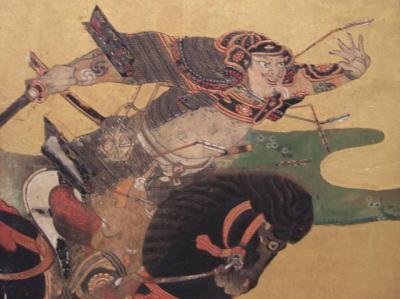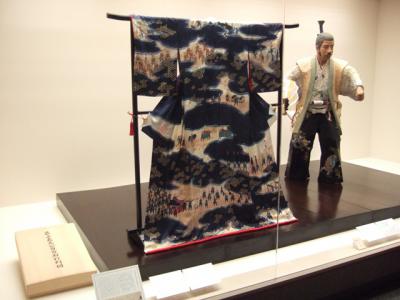最上義光歴史館
歴史館からのお知らせ
肖像画の特別公開
平成26年4月16日(水)〜5月18日(日) 坂紀伊守光秀の命日である元和ニ年(1616)4月26日にちなんだ肖像画の特別公開です。坂家の末裔坂健一氏より当館にご寄託いただいた家宝の坂重内光重の肖像画と当館所蔵の北館大学助利長像もあわせて展示公開しています。  坂紀伊守像(坂光秀像)/山形市・清源寺蔵/山形県指定有形文化財  坂重内光重像/坂健一氏蔵  北館大学助利長像 |
|
《平成25年度2月分の入館者アンケート集計結果》
この集計結果は平成26年2月1日から同28日の間に入館した利用者を対象に行ったアンケートを集計したものです。 企画展 (2/1〜2/28) 開館日数・・・・・・・・・・・・・24日間 入館者数・・・・・・・・・・・・・917人 回答者数・・・・・・・・・・・・・・77人 1.本日は最上義光歴史館に ①企画展を見に来た・・・・・・・・・・・・・・・12% ②常設展示を見に来た・・・・・・・・・・・・・・49% ③両方見に来た・・・・・・・・・・・・・・・・・39% 2.①③の方、企画展を何で知りましたか (1)ポスター・チラシ等・・・・・・・・・・・18% (2)歴史館のホームページ・・・・・・・・・・13% (3)新聞・テレビ・ラジオ等・・・・・・・・・・8% (4)広報やまがた・・・・・・・・・・・・・・・3% (5)知人から聞いた・・・・・・・・・・・・・11% (6)通りがかり・・・・・・・・・・・・・・・29% (7)その他・・・・・・・・・・・・・・・・・18% ②の方、当館をどこで知りましたか (1)旅行雑誌・・・・・・・・・・・・・・・・・8% (2)歴史館のホームページ・・・・・・・・・・13% (3)インターネット・・・・・・・・・・・・・・8% (4)新聞・テレビ・ラジオ等・・・・・・・・・・0% (5)広報やまがた・・・・・・・・・・・・・・・0% (6)知人から聞いた・・・・・・・・・・・・・11% (7)以前から知っていた・・・・・・・・・・・13% (8)観光案内所 (駅など) ・・・・・・・・・・13% (9)通りがかり・・・・・・・・・・・・・・・29% (10)その他・・・・・・・・・・・・・・・・・・5% 3.歴史館の入館は何回目ですか (1)はじめて・・・・・・・・・・・・・・・・82% (2)2回目・・・・・・・・・・・・・・・・・・9% (3)その他・・・・・・・・・・・・・・・・・・9% 4.ご覧になられた感想 (1)内容はいかがでしたか 常設展示 ①大変よかった・・・・・・・・・・・・・32% ②よかった・・・・・・・・・・・・・・・53% ③ふつう・・・・・・・・・・・・・・・・13% ④つまらなかった・・・・・・・・・・・・・1% 企画展 ①大変よかった・・・・・・・・・・・・・38% ②よかった・・・・・・・・・・・・・・・41% ③ふつう・・・・・・・・・・・・・・・・21% ④つまらなかった・・・・・・・・・・・・・0% (2)最上義光と最上家について ①よくわかった・・・・・・・・・・・・・31% ②わかった・・・・・・・・・・・・・・・60% ③わからなかった・・・・・・・・・・・・・0% ④どちらともいえない・・・・・・・・・・・9% 〜利用者の声〜 ◎地元の方の宝物展示は楽しいです。 ◎とってもわかりやすく、なんど来ても、あきなくて、楽しいです。ずっと父と来るつもりです。 ◎展示品が少ない。 ◎無料なのに内容が良いです。 ◎これからも維持して頑張って下さい。 ◎入館料が無料なのでよかった。 ◎市民の宝物がもっと多いと思いました。 ◎歴史にうといので、また足を運びます。 ◎すべての展示にていねいな説明があり、すごくわかりやすかった。有料でも十分価値がある展示の内容だと思いました。 ◎ボランティアガイドさんありがとうございました。 ◎子どもたちがクイズという形で歴史に対して遊び感覚を取り入れてもらっていて、楽しく学ぶことができました。ありがとうございました。 ◎貴重な品が数多く展示されているのは分かったが、パネルの説明が小さかったり、ふりがなが振っていなかったりと、子供、お年寄りにはあまり親切でないと感じた。全体的におとなしすぎる。槍が何の説明なしにただ置いてあるだけなのでもったいないと感じた。山形と最上の関係について、もっと分かりやすい展示にした方が良いと思った。分かる人だけに分かる展示ではいけない。 ◎ガイドの方に案内して頂きよく分かりました。知名度を上げるためにガイド案内をしているとのことでした。興味を持ちますので良い事と思います。 ◎解説の方が大変分かりやすく話していただいてよくわかった。また来てみたいと思います。 ◎入り口正面はもう少し「わくわく」できる展示の方が良いのでは? ◎大変よく分かる説明を受けてよかったです。これからも多くの展示品を期待しています。 ◎大雪の日でしたが大変親切でしたありがとう。 ◎義光は戦うことや産業の活性化にすぐれた人だとは知っていたが、文化にもたけている教養のある人物ということが良く分かって、とても良かった。 ◎お宝店が最高でした。山形バンザイ。 |
山形の呉服商・株式会社とみひろ様(代表取締役冨田浩志氏)から山形市に寄贈になった最上義光公没後四百年記念の着物を特別公開しています。
 ○公開期間 平成26年2月18日(火)から同年4月6日(日)まで ○公開場所 ロビー正面展示ケース ○入館無料 ※長橋阿久於作の木彫彩色「駒姫像」は現在修理中です。 |
|
《平成25年度1月分の入館者アンケート集計結果》
この集計結果は平成26年1月4日から同31日の間に入館した利用者を対象に行ったアンケートを集計したものです。 常設展示 (1/4 〜 1/13) 企画展 (1/16〜1/31) 開館日数・・・・・・・・・・・・・24日間 入館者数・・・・・・・・・・・・・917人 回答者数・・・・・・・・・・・・・・98人 1.歴史館をどこで知りましたか (1)旅行雑誌・・・・・・・・・・・・・・・・・13% (2)歴史館のホームページ・・・・・・・・・・・・5% (3)インターネット・・・・・・・・・・・・・・・5% (4)新聞・テレビ・ラジオ等・・・・・・・・・・・2% (5)広報やまがた・・・・・・・・・・・・・・・・2% (6)知人から聞いた・・・・・・・・・・・・・・・6% (7)以前から知っていた・・・・・・・・・・・・31% (8)観光案内所 (駅など) ・・・・・・・・・・・・9% (9)通りがかり・・・・・・・・・・・・・・・・21% (10)その他・・・・・・・・・・・・・・・・・・・5% 2.歴史館の入館は何回目ですか (1)はじめて・・・・・・・・・・・・・・・・・82% (2)2回目・・・・・・・・・・・・・・・・・・12% (3)その他・・・・・・・・・・・・・・・・・・・6% 3.ご覧になられた感想 (1)内容はいかがでしたか ①大変よかった・・・・・・・・・・・・・・・40% ②よかった・・・・・・・・・・・・・・・・・52% ③ふつう・・・・・・・・・・・・・・・・・・・6% ④つまらなかった・・・・・・・・・・・・・・・2% (2)最上義光と最上家について ①よくわかった・・・・・・・・・・・・・・34% ②わかった・・・・・・・・・・・・・・・・64% ③わからなかった・・・・・・・・・・・・・・1% ④どちらともいえない・・・・・・・・・・・・1% 〜利用者の声〜 ◎最上義光は伊達政宗サイドから悪いイメージであったが、本当の最上義光を知ることが出来ました。 ◎益々のご発展を祈念しております。 ◎やはり長男を殺してしまったことも、きちんと説明すべきだ。 ◎最上と上杉の対立をもっと詳しく知りたいです。 ◎最上義光の足跡と文化人としての風雅さが連歌などに表わされており、寒河江の慈恩寺の三重塔の建立なども相まって、歴史の重みを実感できました。 ◎人形の所は一工夫あってもいいかも。 ◎展示物がシーズンによりかえられ、それが公表されると良いのですが。 ◎ていねいなガイドの説明に感謝。 ◎義光の善行を再認識いたしました。 ◎よく昔のものが保存されていますね。 ◎ボランティアガイドさんが詳しく説明して頂きありがとうございました。山形のPRをもっとすればよいと思う。 ◎最上家の家族や親族のお話を、もう少し詳しく知りたい。誰がどこのお城を守ったかなど。 ◎義光以降の歴史資料の展示も見たかった。 ◎是非「鬼切丸」の実物展示の機会を作ってください。また甲冑や刀剣の展示は照明がポイントです、改善すればもっと良くなります。 ◎義光が勢力を拡大する過程をもう少し詳しく知りたい。(関ヶ原以前) ◎ボランティアガイドの方の説明が大変分かりやすく、理解が深まりました。 |
(C) Mogami Yoshiaki Historical Museum







桜桜桜桜桜桜桜桜桜桜桜桜桜桜桜桜桜桜桜桜桜桜桜桜桜桜桜桜桜桜桜
山形県屈指の桜の名所!!霞城公園(山形城趾)の桜の開花情報をお伝えします!!
≪4月16日(日)13時現在≫
東大手門前街路 【開花】八〜九分咲き
山形城二の丸東大手門 【開花】三分咲き
最上義光、さくらのうた>>こちら
山形市の桜見ごろ情報>>こちら